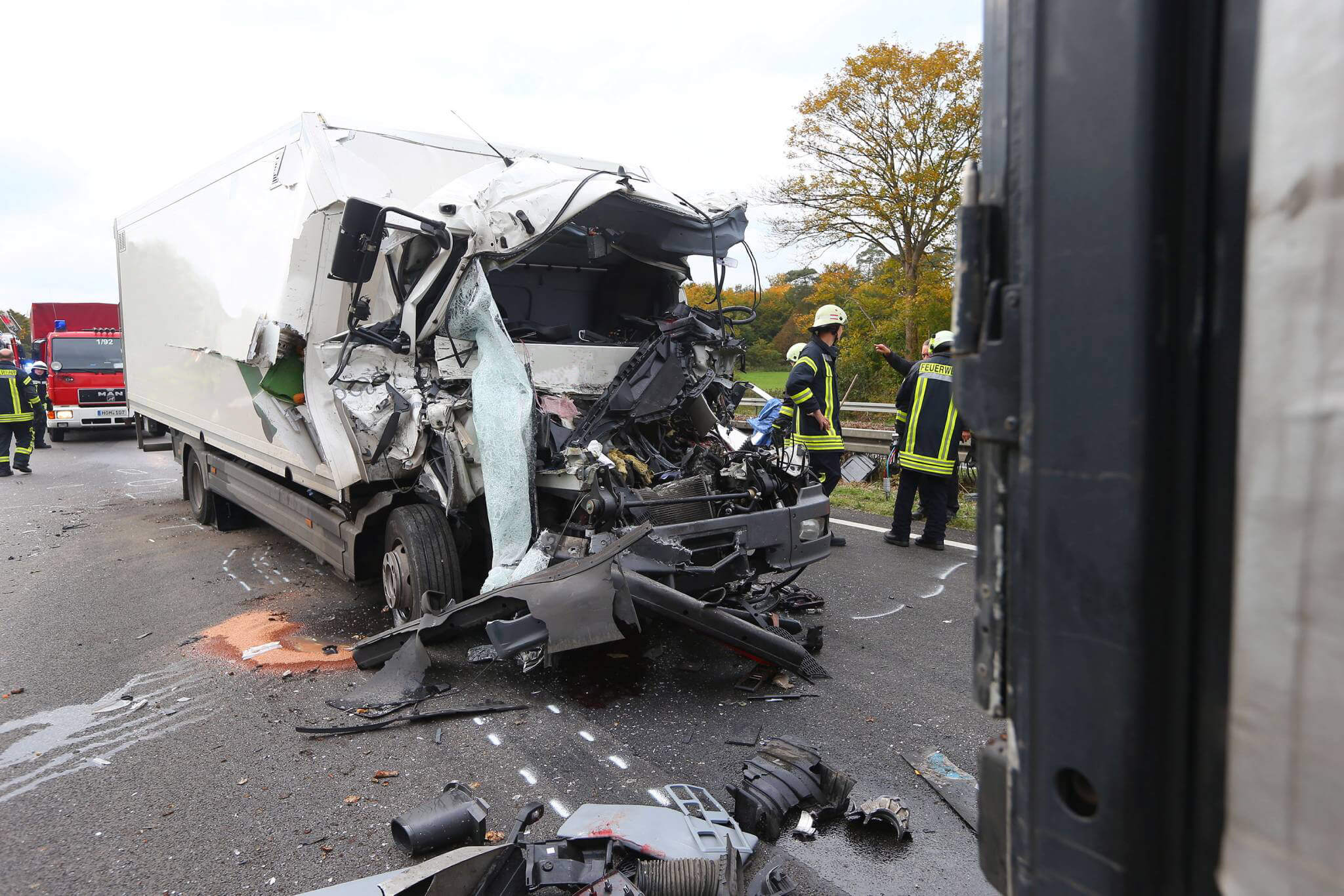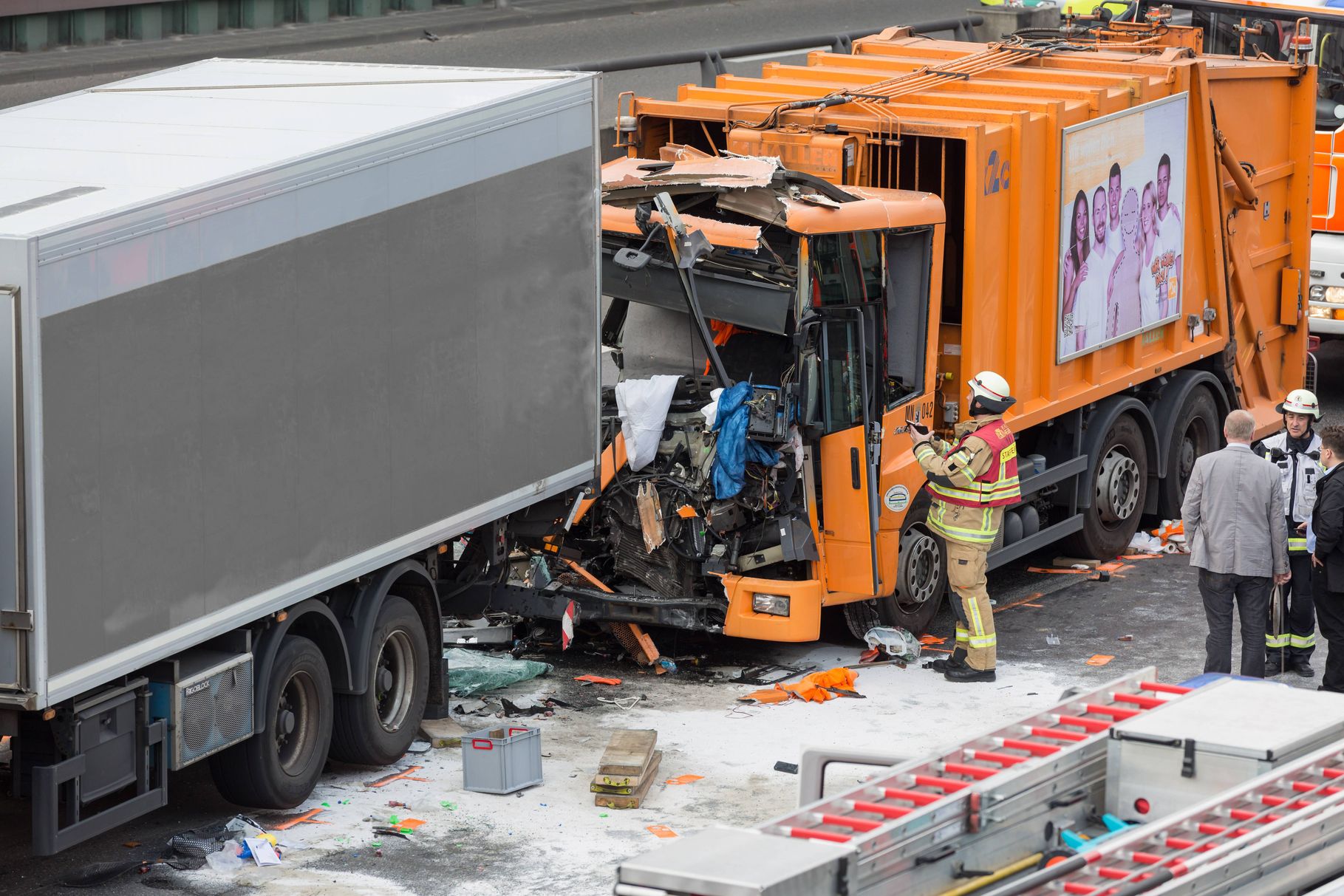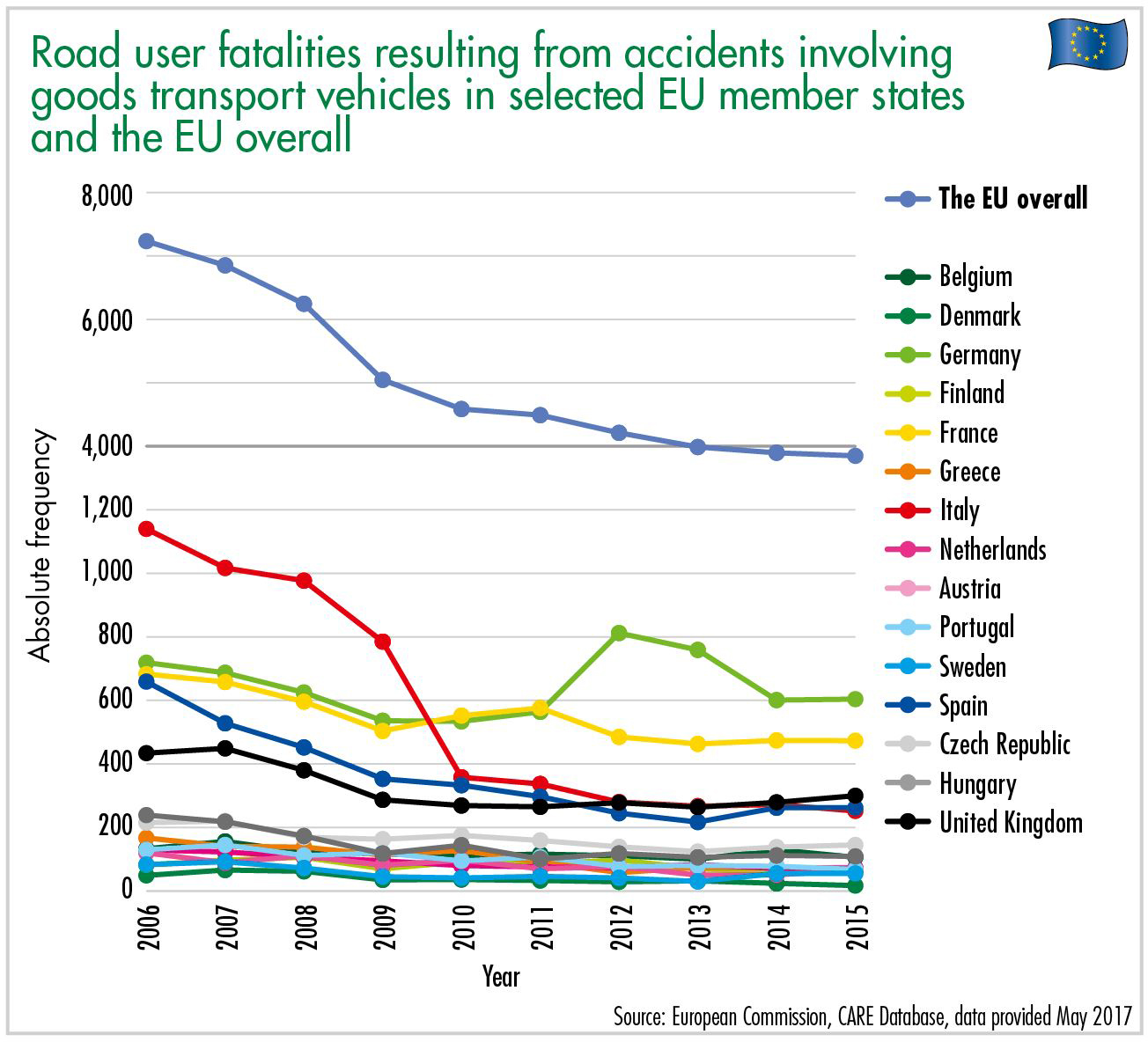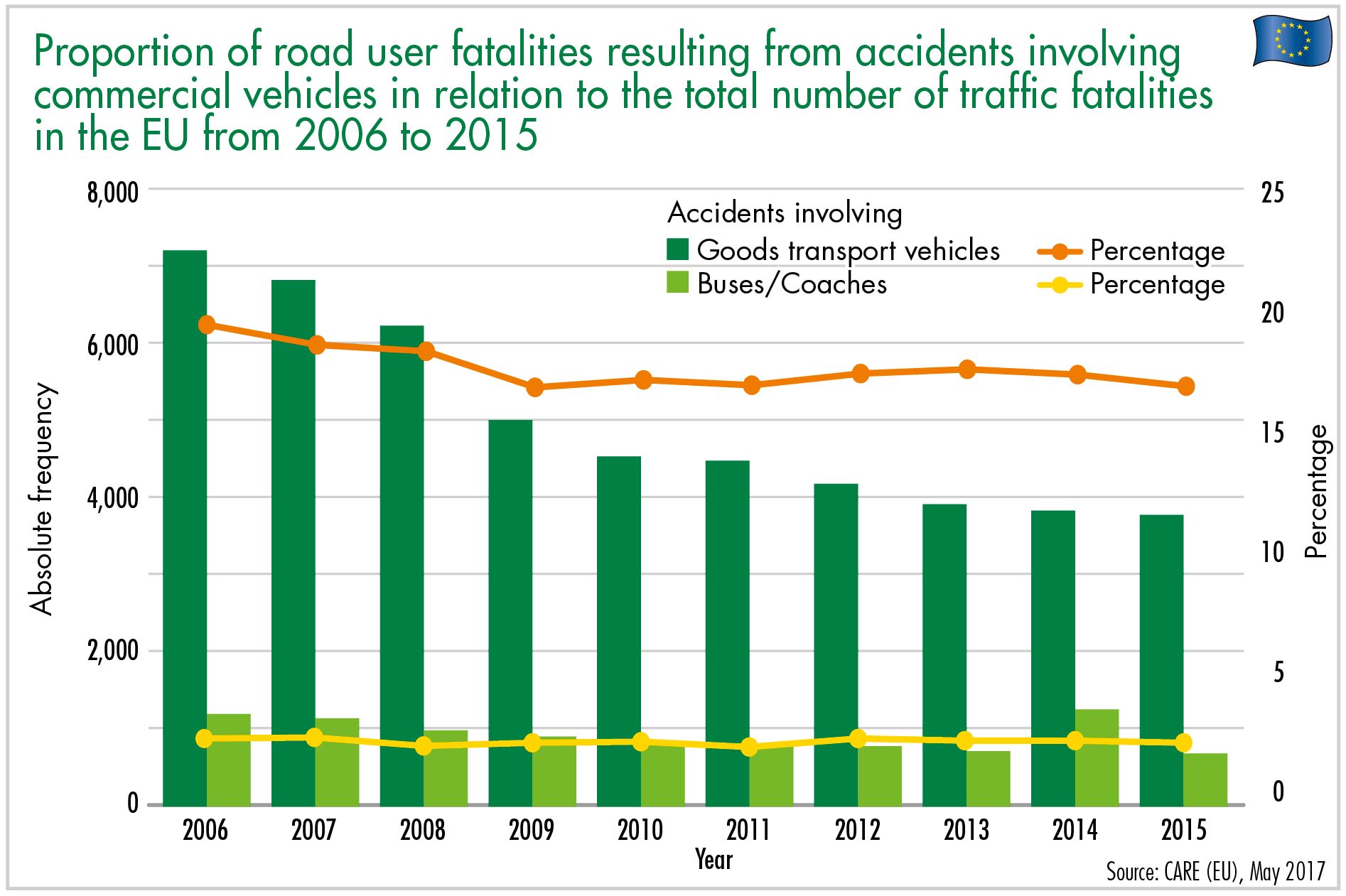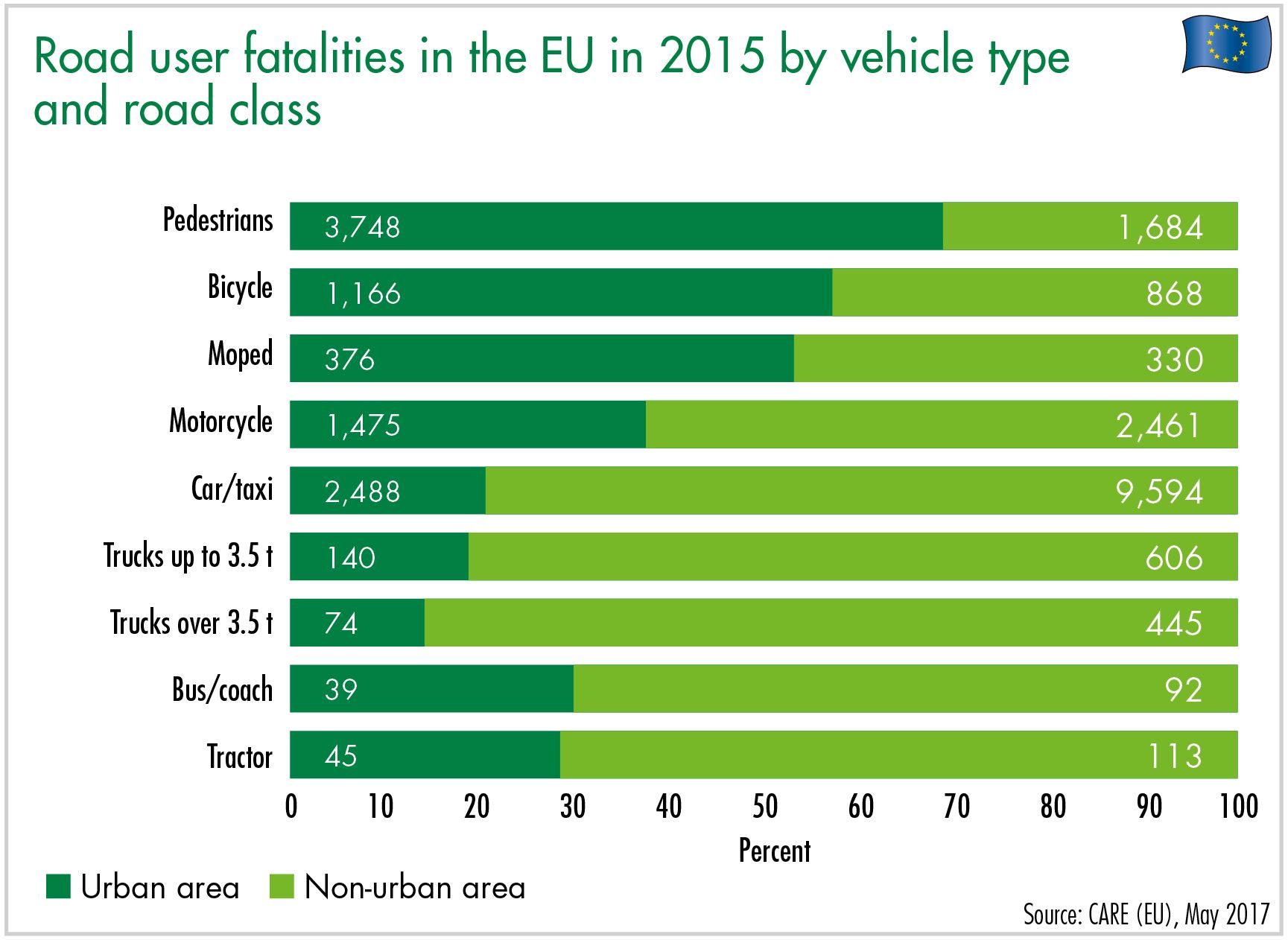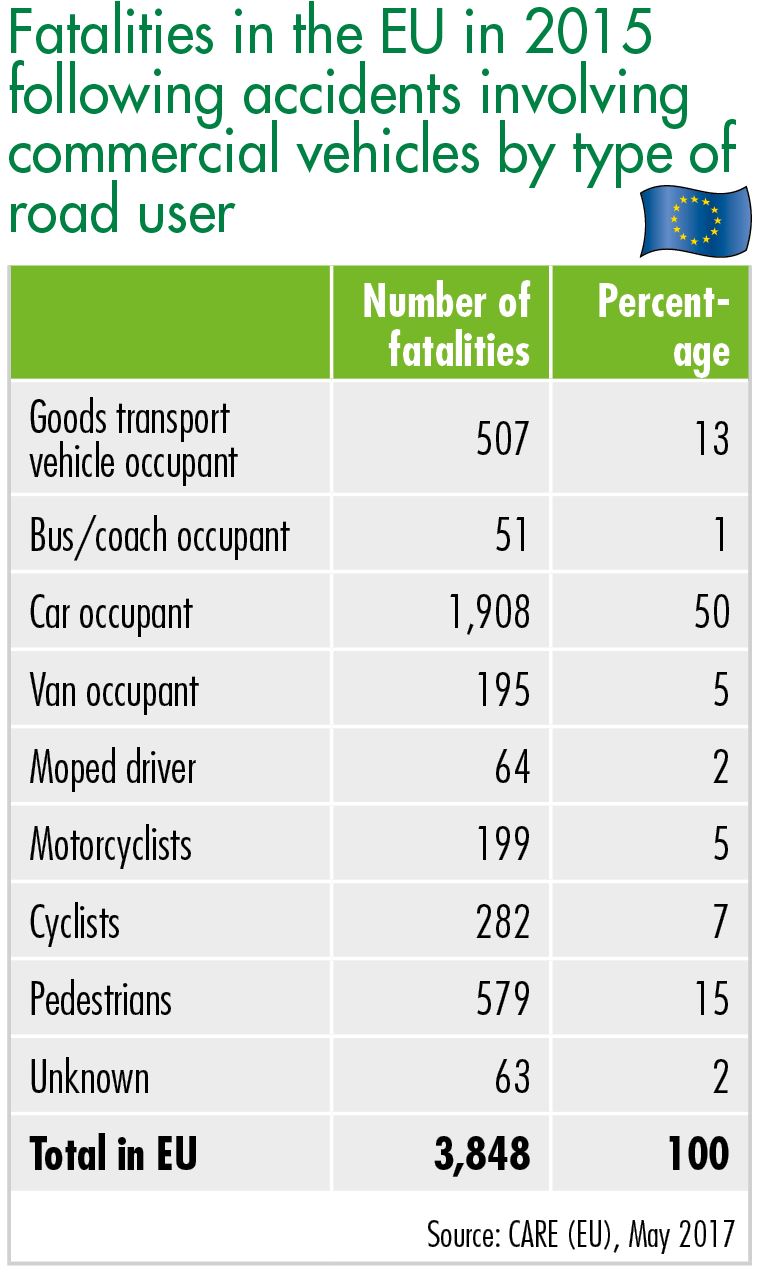A Positive Trend – But Tragic Accidents Still Occur
Accident figures from EU member states, among other regions, show quite clearly that goods transport vehicles are much safer than their reputation would suggest. Compared with cars, the number of people involved in accidents caused by goods transport vehicles is relatively low. However, given the number of vehicles on the road, the higher number of kilometers covered and the longer amount of time spent on roads, drivers are six times more likely to be involved in an accident than other road users.
Monster Crash on the Highway” / “Truck Crashes into the Back of a Traffic Jam Without Braking” / “Three Dead After Accident Involving a Truck Driving the Wrong Way”/ “Family Crushed Between Two Trucks” are just some examples of the headlines we see in the media. The media regularly covers accidents involving commercial vehicles in which people are seriously injured or killed. But as tragic as these cases are for everyone involved, we should not lose sight of the fact that, given the number of kilometers they travel, goods transport vehicles are much less likely to be involved in accidents resulting in personal injury than cars. This is clearly shown, among others, by figures from Germany. According to information provided by the Federal Motor Transport Authority, annual car mileage in Germany in 2016 was around 625 billion kilometers, while goods transport vehicles covered around 82 billion kilometers. In total, approximately 381,000 car drivers and 32,000 goods transport vehicle drivers were involved in an accident resulting in personal injury in 2016. therefore, according to the statistics, 390 goods transport vehicles were involved in traffic accidents resulting in personal injury per billion vehicle kilometers compared with 610 cars. In 2016, the risk of being involved in an accident resulting in personal injury calculated in relation to the amount of distance traveled was almost double for cars compared with goods transport vehicles. In previous years, the factor was 1.5.
The generally positive development regarding goods transport vehicles is further substantiated by the following figures from Germany: In 2000, around 48,500 goods transport vehicle drivers were involved in accidents resulting in personal injury, but by 2016 this figure had decreased by 33 percent. Over this period, however, vehicle mileage had increased by around 40 percent.
Accidents in the EU
The accident figures confirm the generally positive trend that has been seen for a number of years in many parts of the world now. The number of fatalities resulting from accidents involving commercial vehicles weighing over 3.5 metric tons in EU member states, for example, fell from 7,233 in 2006 to 3,848 in 2015, which equates to a decline of around 47 percent. At the time, the latter figure represented almost 15 percent of all traffic fatalities in the EU – approximately 26,000 in total. Countries leading the way in reducing their fatality figures over this period were Italy (minus 78 percent), Spain (minus 60 percent) and Greece (minus 59 percent).
So we can see that the figures are falling sharply, but the percentage of fatalities resulting from accidents involving commercial vehicles in proportion to all traffic fatalities in the EU has remained more or less constant for a number of years now. The other form of transport most frequently involved in accidents – at a level that has also remained more or less constant for a number of years now – is the car, which is reflected in the fact that, in 2015, 1908 car occupants were killed in accidents involving goods transport vehicles. Pedestrians accounted for 15 percent of fatalities resulting from such accidents in 2015, while goods transport vehicle occupants accounted for 13 percent. The latter figure, in particular, provides food for thought because no other occupational group in the EU suffers as many fatalities in the workplace as professional drivers.
Fifty-Five percent of people killed in accidents involving goods transport vehicles died on rural roads, 25 percent in urban areas and 19 percent on highways. It is also notable that the proportion of heavy-duty goods transport vehicle occupants killed in non-urban areas in the EU in 2015 was 86 percent, which is significantly higher than the corresponding figure for other road users.
As far as vans are concerned, most countries see more fatally injured occupants in commercial vehicles weighing up to 3.5 metric tons than in heavy trucks. The only exceptions here, with figures that differ considerably, are Latvia and Slovakia. In the various countries, occupants of commercial vehicle weighing up to 3.5 metric tons are 1.8 times more likely on average to suffer fatal injuries than heavy-duty goods transport vehicle occupants (based on the figures available). The factor in Denmark – 7.8 – is especially extreme. The higher figures for vans can undoubtedly also be attributed to the higher number of vans on the roads. Overall, the CARE figures available for this detailed analysis for the 2001–2010 period show a decrease in the number of fatally injured occupants. Figures decreased by 41.6 percent for truck occupants and 35.3 percent for van occupants. The gaps in the data for the years since 2010 are too big to make a more detailed statement.
European studies on the causes of accidents
If one wants to go into more detail at an international level regarding accidents involving goods transport vehicles, one quickly realizes that standardized statistics are available only to a very limited extent. Even so, for a number of years now, a range of organizations operating within the framework of eSafety (Heavy-Duty Vehicles work group) have attempted to identify the most common accident scenarios in Europe. Accidents in which the vehicle left the road, collisions with trucks traveling ahead, head-on collisions with oncoming cars, side collisions with cars and collisions with pedestrians or cyclists account for between 40 and 62 percent of all accidents in which people are killed or seriously injured.
Published back in 2007, the ETAC Study (ETAC = European Truck Accident Causation) conducted by the International Road Transport Union (IRU) is still a useful reference and offers interesting insights into the fundamental causes of accidents involving trucks in the EU. According to this study, 27 percent of accidents took place at intersections, around 21 percent were rear-end collisions, 20 percent of accidents were related to vehicles leaving the road and just over 11 percent of accidents were caused by overtaking maneuvers. The primary causes of accidents at intersections were drivers disregarding the right of way or traveling with excessive speed. The primary causes of rear-end collisions were drivers traveling with excessive speed or not keeping a suffcient distance from other vehicles. The primary causes of accidents in which vehicles leave the road were drivers traveling with excessive speed or suffering from fatigue. Finally, the primary causes of accidents caused by overtaking maneuvers were carelessness and fatigue.
Accidents in Germany
Several trends seen at EU level are reflected in the number of accidents on German roads. According to the German F cording Federal Statistical Office, a total of 29,353 accidents resulting in personal injury occurred in 2016, with at least one goods transport vehicle being involved. Overall, 32,352 goods transport vehicle drivers were involved in accidents resulting in personal injury in 2016; 48.6 percent of these accidents occurred in urban areas, 26.6 percent occurred on rural roads and 24.8 occurred on highways. As the German Federal Statistical Office explains in its 2016 annual accident report, the different usages of vehicles also become clear when one considers the places where accidents occur. Most accidents – 60 percent – involving small trucks on delivery trips or in the trade sector occur in urban areas; articulated truck drivers, however, were most frequently involved in accidents on highways with a share of almost 50 percent.
A total of 745 people died in accidents involving goods transport vehicles – that is, around 23 percent of all traffic fatalities. Compared with the previous year, this was 42 people fewer (or 5.3 percent less). the number of people seriously injured decreased by 0.8 percent to 7,278; in contrast, the number of people suffering minor injuries increased by 0.4 percent to 32,234. Of the 745 fatalities, 355 persons (47.5 percent) died on rural roads, 206 persons (27.5 percent) died on highways and 184 persons (25 percent) died in urban areas. Regarding the distribution of accident victims relative to different types of road use, it becomes apparent that the dimensions and mass of goods transport vehicles mean that the consequences of accidents are usually much more severe for other road users than for the goods transport vehicle occupants. Of the victims of accidents involving trucks in 2016, 9,483 were goods transport vehicle occupants and 30,774 were other road users. Of the victims who died as a result of the accidents, 133 were goods transport vehicle occupants and 612 were other road users. the risk of being killed in an accident involving a truck is therefore more than four times higher for other people involved in the accident – including fellow passengers – than it is for the goods transport vehicle occupants.
Cars are most frequently the other road user involved in accidents
According to the German Federal Statistical Office, of the total 29,353 accidents resulting in personal injury involving goods transport vehicles, 5.8 percent were single-vehicle accidents resulting in the deaths of 35 goods transport vehicle occupants. In 21,550 of these accidents (73.4 percent), another party was involved; at least three road users were involved in one in Five accidents involving a goods transport vehicle. The other road user most frequently involved in accidents involving two parties was a car (13,194), whereby 207 car occupants and 10 goods transport vehicle occupants were killed. In addition, 96 pedestrians, 77 cyclists and 51 motorcyclists died in 2016 in accidents resulting in personal injury involving goods transport vehicles. In 1,268 accidents, the other road user was also a goods transport vehicle, whereby a total of 55 goods transport vehicle occupants died.
In total, almost 60 percent of all goods transport vehicle drivers involved in accidents were considered to be the main cause of an accident resulting in personal injury. But the figures for this cover a broad range: In the case of people driving small trucks, 64.4 percent were the main cause of the accident; with articulated truck drivers, only 50.6 percent were the main cause. The errors attributed most often to goods transport vehicle drivers included the misjudgment of distances (around 20 percent), errors when drivers “turn, perform U-turns, reverse, pull in or drive off” (16.8 percent), failure to observe right of way/priority (11.2 percent) and “excessive speed” (10.4 percent).
So we can see that the figures are falling sharply, but the percentage of fatalities resulting from accidents involving commercial vehicles in proportion to all traffic fatalities in the EU has remained more or less constant for a number of years now. The other form of transport most frequently involved in accidents – at a level that has also remained more or less constant for a number of years now – is the car, which is reflected in the fact that, in 2015, 1908 car occupants were killed in accidents involving goods transport vehicles. Pedestrians accounted for 15 percent of fatalities resulting from such accidents in 2015, while goods transport vehicle occupants accounted for 13 percent. The latter figure, in particular, provides food for thought because no other occupational group in the EU suffers as many fatalities in the workplace as professional drivers.
Fifty-Five percent of people killed in accidents involving goods transport vehicles died on rural roads, 25 percent in urban areas and 19 percent on highways. It is also notable that the proportion of heavy-duty goods transport vehicle occupants killed in non-urban areas in the EU in 2015 was 86 percent, which is significantly higher than the corresponding figure for other road users.
As far as vans are concerned, most countries see more fatally injured occupants in commercial vehicles weighing up to 3.5 metric tons than in heavy trucks. The only exceptions here, with figures that differ considerably, are Latvia and Slovakia. In the various countries, occupants of commercial vehicle weighing up to 3.5 metric tons are 1.8 times more likely on average to suffer fatal injuries than heavy-duty goods transport vehicle occupants (based on the figures available). The factor in Denmark – 7.8 – is especially extreme. The higher figures for vans can undoubtedly also be attributed to the higher number of vans on the roads. Overall, the CARE figures available for this detailed analysis for the 2001–2010 period show a decrease in the number of fatally injured occupants. Figures decreased by 41.6 percent for truck occupants and 35.3 percent for van occupants. The gaps in the data for the years since 2010 are too big to make a more detailed statement.
European studies on the causes of accidents
If one wants to go into more detail at an international level regarding accidents involving goods transport vehicles, one quickly realizes that standardized statistics are available only to a very limited extent. Even so, for a number of years now, a range of organizations operating within the framework of eSafety (Heavy-Duty Vehicles work group) have attempted to identify the most common accident scenarios in Europe. Accidents in which the vehicle left the road, collisions with trucks traveling ahead, head-on collisions with oncoming cars, side collisions with cars and collisions with pedestrians or cyclists account for between 40 and 62 percent of all accidents in which people are killed or seriously injured.
Published back in 2007, the ETAC Study (ETAC = European Truck Accident Causation) conducted by the International Road Transport Union (IRU) is still a useful reference and offers interesting insights into the fundamental causes of accidents involving trucks in the EU. According to this study, 27 percent of accidents took place at intersections, around 21 percent were rear-end collisions, 20 percent of accidents were related to vehicles leaving the road and just over 11 percent of accidents were caused by overtaking maneuvers. The primary causes of accidents at intersections were drivers disregarding the right of way or traveling with excessive speed. The primary causes of rear-end collisions were drivers traveling with excessive speed or not keeping a suffcient distance from other vehicles. The primary causes of accidents in which vehicles leave the road were drivers traveling with excessive speed or suffering from fatigue. Finally, the primary causes of accidents caused by overtaking maneuvers were carelessness and fatigue.
Accidents in Germany
Several trends seen at EU level are reflected in the number of accidents on German roads. According to the German F cording Federal Statistical Office, a total of 29,353 accidents resulting in personal injury occurred in 2016, with at least one goods transport vehicle being involved. Overall, 32,352 goods transport vehicle drivers were involved in accidents resulting in personal injury in 2016; 48.6 percent of these accidents occurred in urban areas, 26.6 percent occurred on rural roads and 24.8 occurred on highways. As the German Federal Statistical Office explains in its 2016 annual accident report, the different usages of vehicles also become clear when one considers the places where accidents occur. Most accidents – 60 percent – involving small trucks on delivery trips or in the trade sector occur in urban areas; articulated truck drivers, however, were most frequently involved in accidents on highways with a share of almost 50 percent.
A total of 745 people died in accidents involving goods transport vehicles – that is, around 23 percent of all traffic fatalities. Compared with the previous year, this was 42 people fewer (or 5.3 percent less). the number of people seriously injured decreased by 0.8 percent to 7,278; in contrast, the number of people suffering minor injuries increased by 0.4 percent to 32,234. Of the 745 fatalities, 355 persons (47.5 percent) died on rural roads, 206 persons (27.5 percent) died on highways and 184 persons (25 percent) died in urban areas. Regarding the distribution of accident victims relative to different types of road use, it becomes apparent that the dimensions and mass of goods transport vehicles mean that the consequences of accidents are usually much more severe for other road users than for the goods transport vehicle occupants. Of the victims of accidents involving trucks in 2016, 9,483 were goods transport vehicle occupants and 30,774 were other road users. Of the victims who died as a result of the accidents, 133 were goods transport vehicle occupants and 612 were other road users. the risk of being killed in an accident involving a truck is therefore more than four times higher for other people involved in the accident – including fellow passengers – than it is for the goods transport vehicle occupants.
Cars are most frequently the other road user involved in accidents
According to the German Federal Statistical Office, of the total 29,353 accidents resulting in personal injury involving goods transport vehicles, 5.8 percent were single-vehicle accidents resulting in the deaths of 35 goods transport vehicle occupants. In 21,550 of these accidents (73.4 percent), another party was involved; at least three road users were involved in one in Five accidents involving a goods transport vehicle. The other road user most frequently involved in accidents involving two parties was a car (13,194), whereby 207 car occupants and 10 goods transport vehicle occupants were killed. In addition, 96 pedestrians, 77 cyclists and 51 motorcyclists died in 2016 in accidents resulting in personal injury involving goods transport vehicles. In 1,268 accidents, the other road user was also a goods transport vehicle, whereby a total of 55 goods transport vehicle occupants died.
In total, almost 60 percent of all goods transport vehicle drivers involved in accidents were considered to be the main cause of an accident resulting in personal injury. But the figures for this cover a broad range: In the case of people driving small trucks, 64.4 percent were the main cause of the accident; with articulated truck drivers, only 50.6 percent were the main cause. The errors attributed most often to goods transport vehicle drivers included the misjudgment of distances (around 20 percent), errors when drivers “turn, perform U-turns, reverse, pull in or drive off” (16.8 percent), failure to observe right of way/priority (11.2 percent) and “excessive speed” (10.4 percent).
